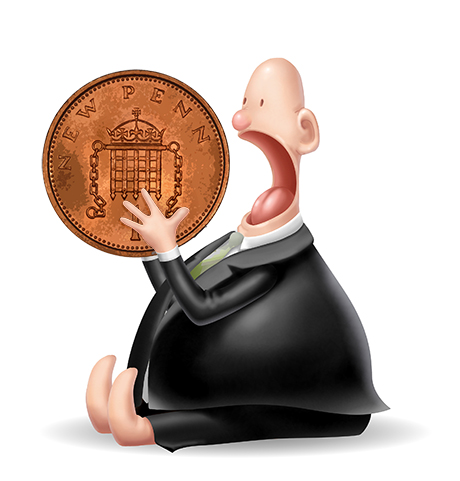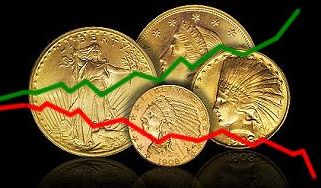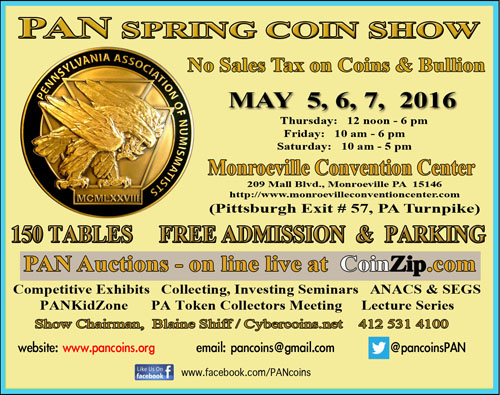By Coinweek ….
Another week has passed so it’s time once again for the CoinWeek Weekly Coin and Currency News Roundup. Here we catch up with the strange and off-center topics that maybe didn’t get the attention they deserved the first time around.
And from everyone at CoinWeek, have a Hopeful and Happy Easter!
Brain Food
1.) A Timeless Question
Over on Sploid, a tech news subsite of Gizmodo.com and a member of the Gawker family of websites, we found an article linking to a video excerpt from the Science Channel show Machines: How They Work that explains how vending machines work. Short and to the point, it uses animation to demonstrate how a currency detecting device knows what coins you inserted and how the validator knows if you inserted a real coin or not.
How things work – how almost anything works – is just plain fascinating. We’re down for a video like this anytime.
Also, keep in mind that the same mechanisms are in countless other machines that deal with metal-based coinage. That’s why changes in the composition of coins, while they might save money for the United States Mint, will have economic repercussions for the vending industry.
How Do Vending Machines Tell the Difference between Fake Coins and Real Coins?
2.) Could an Israeli National Symbol Be a Fake?
For the disquieted Israeli, the moral comforts of archaeology are considerable.
—Amos Elon, The Israelis: Founders and Sons (1971)
At the New Republic’s website, an article by Daniel Estrin discusses the history and importance to the modern Jewish nation of the Seal of Maadana, a relic from the seventh century BCE that belonged to a princess named Maadana. The seal features a 12-stringed lyre and a rare Hebrew inscription from Biblical times.
The symbol even appears on the New Israeli Shekel half shekel coin.
Unfortunately, most scholars consider it a forgery.
Could an Israeli National Symbol Be a Fake?
3.) Penny Sucking Drunk
 In the United States, there’s an urban legend that says sucking on a penny will throw off a breathalyzer test in case the cops pull you over on suspicion for drunk driving. The same story circulates in the UK, only there the coppery bibulist’s friend is a two-pence coin.
In the United States, there’s an urban legend that says sucking on a penny will throw off a breathalyzer test in case the cops pull you over on suspicion for drunk driving. The same story circulates in the UK, only there the coppery bibulist’s friend is a two-pence coin.
Well, men’s magazine Joe is at it again, providing the Weekly Roundup with another entertaining coin-related news piece. This time, they put the kibbosh on the barfly’s old wives’ tale by recounting the story of one Daniel Potts from Ipswitch.
Sucking on a 2p Coin Won’t Beat a Drink Driving Ban
Internet urban legend debunkers Snopes.com have an even more in-depth examination of why it doesn’t work.
World of the Weird
4.) The Most Recognizable Coin Sound in the World
From the “What? They Hadn’t Done It Yet?” Department comes news that Nintendo Corporation has filed for a Japanese trademark on the world-famous sound that Mario makes when he hits a coin block in any of the Super Mario Brothers video games.

Looking at the musical notation, it reminds us of another überfamous micro-composition: Brian Eno’s (yes, that Brian Eno!) startup sound for Windows 95.
Nintendo Applies for Trademark on Mario’s Coin Sound
5.) Upvote for Edmar
The Internets loves an underdog.
 A Filipino man named Leandro Alverio Santos II happened across a small boy selling coin banks made to look like houses on the streets of Manila. He struck up a conversation with the boy and learned that 11-year-old Edmar helps make the coin banks with his mother, whom he travels with to Manila from another town to sell their wares to passers-by.
A Filipino man named Leandro Alverio Santos II happened across a small boy selling coin banks made to look like houses on the streets of Manila. He struck up a conversation with the boy and learned that 11-year-old Edmar helps make the coin banks with his mother, whom he travels with to Manila from another town to sell their wares to passers-by.
After Mr. Santos uploaded the photos to the internet, along with Edmar’s story, people all around the world became enamored of the boy and his determination to do something to make life a little bit better for himself and his family other than beg on the streets.
And in typical internet fashion, Mr. Santos is hoping to parlay this potentially fleeting fame into something even more profitable for Edmar and his mother.
Boy Selling Coin Banks in Manila Draws Admiration from the Net
6.) Buy a Pepper, Get a Coin
Produce industry trade website The Packer writes about how Prime Time International, a “grower-shipper of multi-colored peppers”, has decided to celebrate its 25th anniversary with a commemorative silver coin promotional giveaway.
Inside select packages of Prime Time peppers will be a red envelope. Inside the envelope is a form that the lucky pepper connoisseur can fill out and return to the company in exchange for a polo shirt and silver coin.
We haven’t been this excited about free food-based precious metal coins since the Doritos Jacked™ 24-karat giveaway a couple years ago!
Produce Company Packs Silver Coin with Peppers
Treasure News
7.) A Paraguayan Treasure Hunt
The New York Times recently wrote about a curious South American phenomenon.
In Paraguay, the people have long told stories of the fabulous riches buried for hundreds of miles all around the capital city of Asunción by the rich and the powerful as they fled the forces of Argentina, Uruguay and Brazil during the War of the Triple Alliance (1864-70).
Some buried British pounds. Others buried gold and silver bullion. Somebody buried gold pineapples(!).
And everyone seems to have caught treasure hunting fever. But is that a bad thing?
The Dream of Treasure Keeps Paraguayans Digging
8.) Portuguese Shipwreck off the Coast of Oman
Divers off the coast of Oman on the Arabian Peninsula may have discovered the wreckage site of Esmeralda, a ship belonging to the fleet of famed Portuguese explorer Vasco da Gama, the first European to discover a sea route to India from Europe.
If the ship turns out to be Esmeralda, it is officially the earliest shipwreck discovered from the Age of Exploration. Esmeralda sank in May of 1503.
Of course treasure has been found at the site, including numerous gold coins and a rare silver coin known as an indio – a type of coin minted especially for use by the Portuguese in India. The indio recovered off the coast of Oman is dated 1499 and is almost unique. Only one other sample was known until this discovery.
It’s been a good month for second-known examples; an Israeli woman found a rare aureus of Trajan with a commemorative portrait of Augustus on the obverse during a hike earlier this month.
Crime & Punishment
 9.) NCIC Crime Bulletin
9.) NCIC Crime Bulletin
From the Numismatic Crime Information Center (NCIC):
Investigators with the Logan County Sheriff’s Office in Colorado are looking for any dealer or collector who knows of any victim or has done business with subjects identified as Christopher Wayne Roberts of Beaumont, Texas or Donald Scott Rainey of Nederland, Texas. Both individuals worked at Vintage World Coin in Nederland.
The Sheriff’s Department has issued warrants for the two for Theft over $28,000 and Crimes Against at Risk Elders.
Details in the warrant affidavit indicate that the victim was contacted by a representative of Vintage World Coin who was interested in the victim’s coin collection.The sales representative called numerous times pushing the victim into allowing someone from his company to come and assess the value of his coins. The victim finally agreed and Roberts and Rainey traveled to Colorado and met the victim at his residence.
It was agreed that Roberts and Rainey would take the coins for an appraisal and return them at the end of the week. The coins were never returned and the victim filed a report with the Logan County Sheriff’s Office.
Anyone with information should email Detective Rick Jandegian at [email protected] or call (970) 522-2578.
Additionally, anyone with information can contact the NCIC’s Doug Davis at (817) 723-7231 or [email protected]
The Numismatic Crime Information Center is a 501 (c)(3) non-profit corporation. P.O. Box 14080 Arlington, Texas 76094.
Current Events
10.) The Great Debate
Colonialism and Western Imperialism have left lasting scars in much of the rest of the world. One continuing legacy of this exploitation is the holding of foreign cultural artifacts in the museums and institutions of the former Western powers. Consequently, the repatriation of such objects to their homelands has been a hot political and social issue for decades.
Two articles continued the great debate last week, both worth reading. At first glance the answer seems clear but as with many things in life, the problem is far more complex than one might think.
Does one ethnic group own its cultural artefacts? (longer)
When it comes to ancient treasures, are we owners, thieves or caretakers? (shorter)
11.) Rare Coin Index
 A financial index consisting of 200 rare British coins has apparently bested the performance of the Financial Times Stock Exchange (FTSE) 100.
A financial index consisting of 200 rare British coins has apparently bested the performance of the Financial Times Stock Exchange (FTSE) 100.
Described as an “alternative asset” in the article, the values of the rare coins outperformed the returns garnered from a list of 100 stocks chosen by the Financial Times as a bellwether of the global economy.
As people prone to worrying about the line between collecting and investing, we’re not sure how to feel about that…
Rare Coin Index Beats the FTSE 100
In Memoriam
12.) Princess Joan of Sealandia
The Principality of Sealandia was officially founded on September 2, 1967, when Roy Bates and his wife Joan declared the independence of the offshore Air Force defense tower known as Roughs Tower from the United Kingdom.
It is one of the most famous micronations in the world, and is of interest to many numismatists and collectors of exonumia, having minted three issues of gold and silver coins in the 1970s.
The effigy of the Sovereign Princess Joan Bates née Collins adorned the obverse of each one.
Sadly, she passed away on March 10, 2016.
Remembering Sealand’s First Sovereign Princess Joan, 1929-2016
Worthy Additions to Your Library
Per usual, the American Numismatic Society (ANS) is good for a book or two. Contact the ANS director of publications, Andrew Reinhard, at [email protected] to order or pre-order any of the books below that are for sale.
13.) Rise of the Dollar
According to the ANS March newsletter, the society has over a dozen copies of the new book A Superpower is Born: The Rise of the Dollar (2016) to sell. The slim 80-page volume consists of seven chapters illustrated in full-color and written by numismatists from around the world.
14.) Humanities Open Book Project
The ANS Digital Library has produced its first ebook, Sydney Noe’s Coin Hoards (1920).
15.) AJN 27 Soon Available
Volume 27 of the American Journal of Numimatics (AJN) is currently at the printers and will be mailed to all members except those at the “Basic” level when it is ready.
16.) Irritamenta
Irritamenta: Numismatic Treasures of a Renaissance Collector (Numismatic Studies Volume 31), written by John Cunnally, associate professor of Art and Visual Culture specializing in Renaissance art history at Iowa State University, is a 414-page, two-volume set about the collection of one Andreas Loredan, a wealthy 16th-century coin collector from Venice. It contains over 300 color plates.
Irritamenta: Numismatic Treasures of a Renaissance Collector
17.) New Books on Frankish Coins & Byzantine Numismatics
Lastly, as far as this week’s book news goes anyway, CoinsWeekly wrote about two new books concerning Frankish coins in Greece and Byzantine numismatics.
The first book, Coins of the Frankish Occupation of Greece 1184-1566, was written by Anastasios P. Tzamalis and is a combination of his 1981 work Nomismata tis Frangokratias 1184-1566 and other articles Tzamalis has written since then.
The second book, written by Jean Svoronos, is entitled Byzantiaka Nomismatika Zitimata (Byzantine Numismatic Issues) is a similar compilation of six studies written by the author over time.
New Books on Frankish Coins & Byzantine Numismatics
18.) Kolbe & Fanning March Fixed Price Catalog
Numismatic booksellers Kolbe & Fanning have announced the release of their March 2016 fixed price catalog. Including a number of books on a wide variety of topics, the free catalog is available for download on their website, numislit.com.
Coin Show Shout-Out

This week’s Coin Show Shout-Out goes out to the Pennsylvania Association of Numismatists (PAN) and the upcoming 2016 PAN Spring Coin Show, running May 5 through 7 at the Monroeville Convention Center in Monroeville, Pennsylvania.
There are 150 tables at the show, with 100 dealers attending to buy, sell and trade.
Collectors can win prizes for the best educational numismatic exhibits.
Drawings for free American Silver Eagles will be held hourly, and an auction of Chinese coins will take place at the show as well.
Also, don’t forget about the award-winning KidZone, where children under 18 can learn about coins as they fill date folders, participate in talks, win giveaways and place their bids in a kids auction using the PAN dollars they earned through other activities.
The John Burns Memorial Traveling Library will also be available to attendees. The free library is named for the late numismatic bookseller and PAN charter member John H. Burns, whose personal selection of books forms the core of the traveling library.
The library will also be making an appearance at the 77th annual Central States Numismatic Society (CSNS) Convention in Rosemont, Illinois on April 28-30.
Visit pancoins.org for more information.




